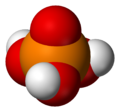Orthophosphoric acid
 |
|||
|
|
|||
| Names | |||
|---|---|---|---|
|
IUPAC name
Phosphoric acid; trihydroxidooxidophosphorus
|
|||
| Other names
Orthophosphoric acid; Trihydroxylphosphine oxide
|
|||
| Identifiers | |||
|
7664-38-2 16271-20-8 />16271-20-8 (hemihydrate) |
|||
| 3D model (Jmol) | Interactive image | ||
| ChEBI |
CHEBI:26078 |
||
| ChEMBL |
ChEMBL1187 |
||
| ChemSpider |
979 |
||
| ECHA InfoCard | 100.028.758 | ||
| EC Number | 231-633-2 | ||
| E number | E338 (antioxidants, ...) | ||
| KEGG |
D05467 |
||
| PubChem | 1004 | ||
| RTECS number | TB6300000 | ||
| UNII |
E4GA8884NN |
||
| UN number | 1805 | ||
|
|||
|
|||
| Properties | |||
| H3O4P | |||
| Molar mass | 97.99 g·mol−1 | ||
| Appearance | white solid or colourless, viscous liquid (>42 °C) deliquescent |
||
| Odor | odorless | ||
| Density | 1.885 g/mL (liquid) 1.685 g/mL (85% solution) 2.030 g/mL (crystal at 25 °C) |
||
| Melting point | 42.35 °C (108.23 °F; 315.50 K) (anhydrous) 29.32 °C (84.78 °F; 302.47 K) (hemihydrate) |
||
| Boiling point | 158 °C (316 °F; 431 K) 213 °C (415 °F; 486 K) decomposes |
||
| 392.2 g/100 g (−16.3 °C) 369.4 g/100 mL (0.5 °C) 446 g/100 mL (14.95 °C) miscible (42.3 °C) |
|||
| Solubility | soluble in ethanol | ||
| Vapor pressure | 0.03 mmHg (20°C) | ||
| Acidity (pKa) | pKa1 = 2.148 pKa2 = 7.198 pKa3 = 12.319 |
||
| −43.8·10−6 cm3/mol | |||
|
Refractive index (nD)
|
1.3420 (8.8% w/w aq. soln) 1.4320 (85% aq. soln) 25 °C |
||
| Viscosity | 2.4–9.4 cP (85% aq. soln.) 147 cP (100%) |
||
| Structure | |||
| monoclinic | |||
| Thermochemistry | |||
|
Std molar
entropy (S |
158 J/mol·K | ||
|
Std enthalpy of
formation (ΔfH |
-1288 kJ/mol | ||
| Hazards | |||
| Safety data sheet | ICSC 1008 | ||
| GHS pictograms |  |
||
| GHS signal word | Corrosive | ||
| H290, H314 | |||
| P280, P305+351+338, P310 | |||
|
EU classification (DSD)
|
|||
| R-phrases | R34 | ||
| S-phrases | (S1/2), S26, S45 | ||
| NFPA 704 | |||
| Flash point | Non-flammable | ||
| Lethal dose or concentration (LD, LC): | |||
|
LD50 (median dose)
|
1530 mg/kg (rat, oral) | ||
| US health exposure limits (NIOSH): | |||
|
PEL (Permissible)
|
TWA 1 mg/m3 | ||
|
REL (Recommended)
|
TWA 1 mg/m3 ST 3 mg/m3 | ||
|
IDLH (Immediate danger)
|
1000 mg/m3 | ||
| Related compounds | |||
|
Related phosphorus oxoacids
|
Hypophosphorous acid Phosphorous acid Pyrophosphoric acid Triphosphoric acid Perphosphoric acid Permonophosphoric acid |
||
|
Except where otherwise noted, data are given for materials in their standard state (at 25 °C [77 °F], 100 kPa).
|
|||
|
|
|||
| Infobox references | |||
Phosphoric acid (also known as orthophosphoric acid or phosphoric(V) acid) is a mineral (inorganic) acid having the chemical formula H3PO4. Orthophosphoric acid refers to phosphoric acid, which is the IUPAC name for this compound. The prefix ortho is used to distinguish the acid from related phosphoric acids, called polyphosphoric acids. Orthophosphoric acid is a non-toxic acid, which, when pure, is a solid at room temperature and pressure. The conjugate base of phosphoric acid is the dihydrogen phosphate ion, H
2PO−
4, which in turn has a conjugate base of hydrogen phosphate, HPO2−
4, which has a conjugate base of phosphate, PO3−
4. Phosphates are nutritious for all forms of life.
In addition to being a chemical reagent, phosphoric acid has a wide variety of uses, including as a rust inhibitor, food additive, dental and orthop(a)edic etchant, electrolyte, flux, dispersing agent, industrial etchant, fertilizer feedstock, and component of home cleaning products. Phosphoric acids and phosphates are also important in biology.
...
Wikipedia



